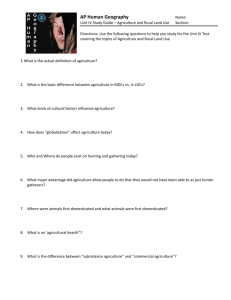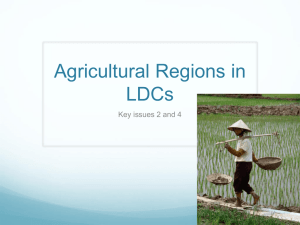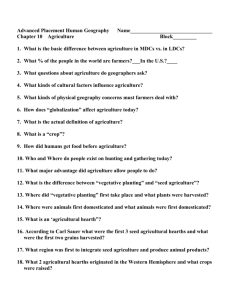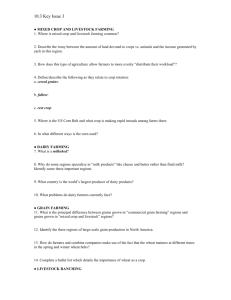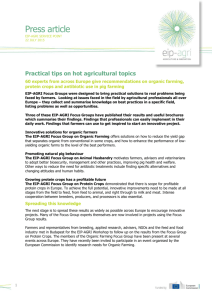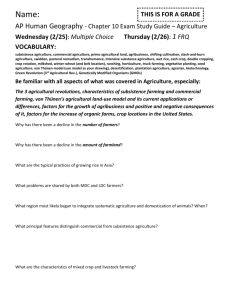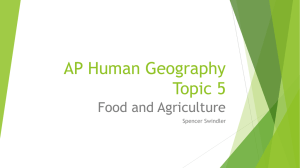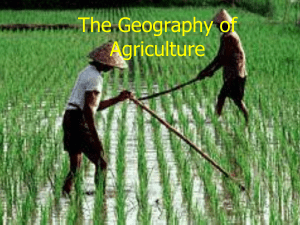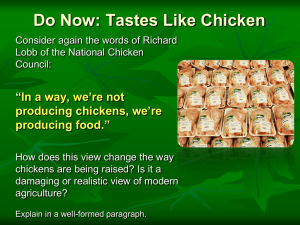The Geography of Agriculture
advertisement
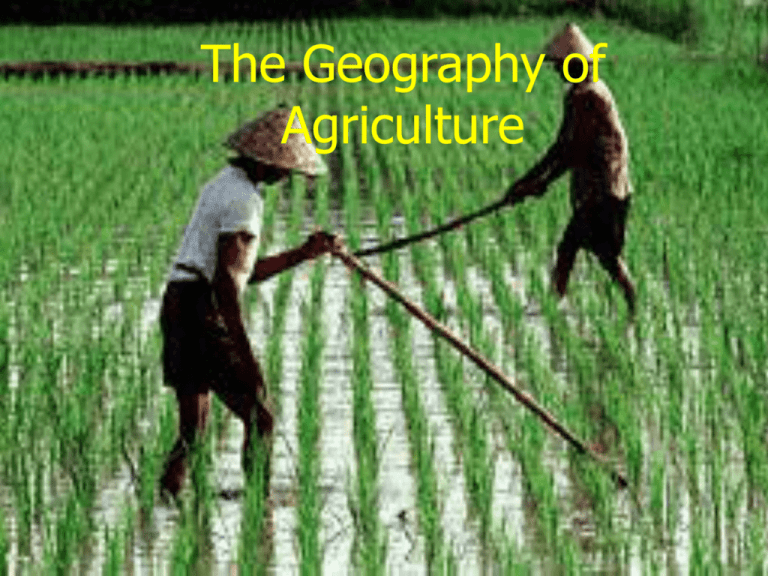
The Geography of Agriculture The Geography of Agriculture • A Brief History of Agriculture • Classifying Agricultural Regions • Intensity of Land Use and the Von ThÜnen Model • Questioning our Agricultural ‘Success’ History of Agriculture • Hunter-Gatherers • Neolithic Revolution – Domestication of Plants and Animals – Diffusion of Agriculture • Agricultural Industrialization • The “Green Revolution” • Modern Agribusiness Hunter-Gatherers • Humanity’s only “economic” activity for at least 90% of our existence. • Low population densities. • Wide variety of natural foodstuffs eaten. Diffusion of Agriculture Cultural Hearths: Near East, East Asia, Mesoamerica Stimulus Diffusion - only idea is transferred. Neolithic Revolution Primary effects: Urbanization Social Stratification Occupational Specialization Increased population densities Secondary effects: Endemic diseases Famine Expansionism Modern Agricultural Revolutions Technology allows much greater production (surplus) with less human labor, but has high social and environmental costs. Metal plows, Reapers, Cotton Gin Tractors (Internal Combustion Engine) Combines Chemical Pesticides/Fertilizers Hybrid and genetically modified crops Agribusiness: The industrialization of agriculture Modern commercial farming is very dependent on inputs of chemical fertilizer, pesticides, herbicides. Oil is required to make fertilizer and pesticides. It takes 10 calories of energy to create 1 calorie of food in modern agriculture. Small farmer can’t buy needed equipment and supplies. Fewer than 2% of U.S. population works in agriculture Classifying Agricultural Regions Subsistence Agriculture • Shifting Cultivation • Pastoral Nomadism • Intensive Subsistence Agriculture Subsistence Farms, China Subsistence Agriculture Regions Shifting Cultivation Vegetation “slashed” and then burned. Soil remains fertile for 2-3 years. Then people move on. where: tropical rainforests. Amazon, Central and West Africa, Southeast Asia Crops: upland rice (S.E. Asia), maize and manioc (S. America), millet and sorghum (Africa) Declining at hands of ranching and logging. Pastoral Nomadism The breeding and herding of domesticated animals for subsistence. Bedouin Shepherd Somali Nomad and Tent where: arid and semi-arid areas of N. Africa, Middle East, Central Asia animals: Camel, Goats, Sheep, Cattle transhumance: seasonal migrations from highlands to lowlands Most nomads are being pressured into sedentary life as land is used for agriculture or mining. Intensive Subsistence Agriculture • Wet Rice Dominant The Fields of Bali Thai Rice Farmers where: S.E. Asia, E. India, S.E. China very labor intensive production of rice, including transfer to sawah, or paddies most important source of food in Asia grown on flat, or terraced land Double cropping is used in warm winter areas of S. China and Taiwan Classifying Agricultural Regions Commercial Agriculture • Mixed Crop and Livestock Farming • Dairy Farming • Grain Farming • Livestock Ranching • Mediterranean Agriculture • Truck Farming North Dakota Potato and Wheat Fields Mixed Crop and Livestock Farming Mixed Crop and Livestock Farming Where: Ohio to Dakotas, centered on Iowa; much of Europe from France to Russia crops: corn (most common), soybeans In U.S. 80% of product fed to pigs and cattle Highly inefficient use of natural resources Pounds of grain to make 1 lb. beef: 10 Gallons of water to make 1 1b wheat: 25 Gallons of water to make 1 1b. beef: 2500 Dairy Farming Where: near urban areas in N.E. United States, Southeast Canada, N.W. Europe Locational Theory: butter and cheese more common than milk with increasing distance from cities and in West. milkshed: historically defined by spoilage threat; refrigerated trucks changed this. Dairy Farm, Wisconsin Von ThÜnen Model (Rings) Von Thunen is beginning of location economics and analysis (1826) Grain Farming Where: worldwide, but U.S. and Russia predominant Crops: wheat winter wheat: Kansas, Colorado, Oklahoma spring wheat: Dakotas, Montana, southern Canada Highly mechanized: combines, worth hundreds of thousands of dollars, migrate northward in U.S., following the harvest. Livestock Ranching Where: arid or semi-arid areas of western U.S., Argentina, Brazil, Uruguay, Spain and Portugal. History: initially open range, now sedentary with transportation changes. Environmental effects: 1) overgrazing has damaged much of the world’s arid grasslands (< 1% of U.S. remain!) 2) destruction of the rainforest is motivated by Brazilian desires for fashionable cattle ranches Mediterranean Agriculture Where: areas surrounding the Mediterranean, California, Oregon, Chile, South Africa, Australia Climate has summer dry season. Landscape is mountainous. • crops: olives, grapes, nuts, fruits and vegetables; winter wheat • California: high quality land is being lost to suburbanization; initially offset by irrigation Commercial Gardening and Fruit Farming Where: U.S. Southeast, New England, near cities around the world • crops: high profit vegetables and fruits demanded by wealthy urban populations: apples, asparagus, cherries, lettuce, tomatoes, etc. • mechanization: such truck farming is highly mechanized and labor costs are further reduced by the use of cheap immigrant (and illegal) labor. • distribution: situated near urban markets. Plantation Farming • large scale mono-cropping of profitable products not able to be grown in Europe or U.S. • where: tropical lowland Periphery • crops: cotton, sugar cane, coffee, rubber, cocoa, bananas, tea, coconuts, palm oil. What are potential problems with this type of agriculture? Environmental? Economic? Making Sense of the Map of US Agricultural Regions Green Revolution The in Agriculture The Green Revolution in Agriculture The term green revolution refers to the development and adoption of high yielding cereal grains in the less developed world during the 1960s, 1970s, and 1980s. Very large short term gains in grain output have allowed food supplies to grow faster than populations, until very recently. • • • • Green Revolution History Acreage and Yield Trends Technical Problems Ethical Issues Acreage and Yield Trends Acreage and Yield Trends Acreage and Yield Trends History of Green Revolution 1943 Rockefeller Foundation begins work on short stature hybrid corn in Mexico 1960s Hybrid strains of rice, wheat, and corn show great success in S.E. Asia, and Latin America. 1970 Head of Mexican corn program, Borlaug, wins Nobel Peace Prize 1990s Growth in food supply continues, but slows to below the rate of population growth, as the results of unsustainable farming practices take effect. Acreage and Yield Trends Gains were made by: • Dwarf varieties: plants are bred to allocate more of their photosynthetic output to grain and less to vegetative parts. • Planting in closer rows, allowed by herbicides, increases yields. • Bred to be less sensitive to day length, thus double-cropping is more plausible. • Very sensitive to inputs of fertilizer and water. Technical and Resource Limitation Problems • Heavy Use of Fresh Water • High Dependence on Technology and Machinery Provided/Sold by Core Countries • Heavy Use of Pesticides and Fertilizer • Reduced Genetic Diversity / Increased Blight Vulnerability • Questionable Overall Sustainability Ethical Issues • Starvation of many prevented, but extra food may lead to higher birth rates. • Life expectancy in less developed countries increased by 10 years in less than two decades (43 in 1950’s to 53 in 1970’s). • Dependency on core countries increased; rich-poor gap increased. • Wealthy farmers and multinational companies do well, small farmers become wage laborers or unemployed – dependent. • More at risk? More people malnourished/starving today than in 1950 (but lower as a percentage). • U.S. spends $10,000,000,000 year on farm subsidies, damaging farmers and markets in LDCs. Agricultural ‘Success’? “Our incredible successes as a species are largely derived from this choice, but the biggest threats to our existence stem from the same decision.” Jared Diamond, 1999 Emergence of new human diseases from animal diseases (i.e. smallpox, measles) • Dense urban populations allow spread/persistence of disease Lower standard of living for many people. • Archaeological evidence of serious mal-nourishment among early farmers. • Many modern impoverished and malnourished farmers. • Famine virtually non-existent in hunter-gatherer societies. Increased susceptibility to plant blights and increased dependence on complex economic systems. Environmental degradation • topsoil loss (75% in U.S.), desertification, eutrophication, PCBs in fish, DDT and other pesticides
